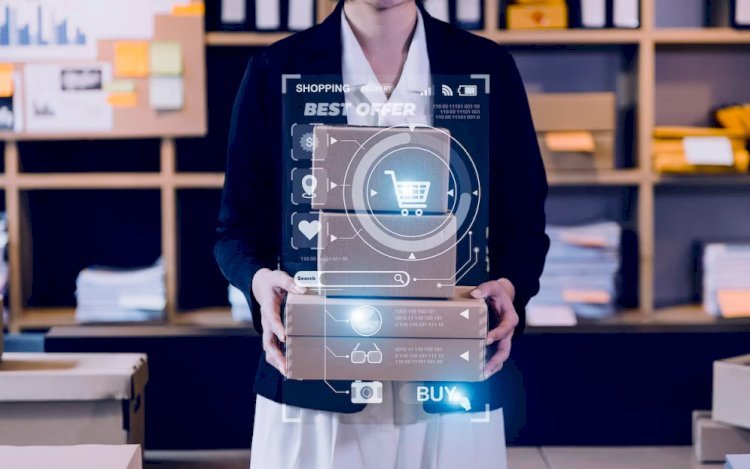Ecommerce Business Intelligence in 2025: Tools, Trends, and How It Drives Growth
Discover how Ecommerce Business Intelligence is transforming online businesses in 2025. Learn the tools, trends, and strategies to boost your ecommerce growth today!

In today’s competitive ecommerce world, making fast and smart decisions is the key to staying ahead. That’s where Ecommerce Business Intelligence (BI) comes in. In simple words, ecommerce BI means using your store’s data — customer behavior, sales trends, product performance — to make better choices that lead to real growth. With global ecommerce sales expected to cross $7 trillion in 2025 (Statista), brands need more than guesswork to succeed. Whether you’re running a small Shopify store or managing a global brand, a strong BI strategy can help you deliver better experiences, increase profits, optimize marketing, and scale efficiently. In this guide, we’ll break down what ecommerce BI means, the best tools for 2025, key trends, and how it can drive major growth for your online business.
What Is Ecommerce Business Intelligence?

Ecommerce Business Intelligence (BI) is the process of collecting and analyzing your store’s data — sales figures, marketing results, inventory levels, and customer activities — to guide smarter business decisions. Instead of guessing what will sell or what customers want, BI tools reveal real-time insights you can act on immediately.
By 2025, ecommerce BI is more powerful than ever. It combines artificial intelligence (AI), machine learning, and predictive analytics to forecast future trends, spot problems early, and help businesses stay ahead. From personalizing marketing campaigns to predicting inventory needs, ecommerce BI turns numbers into clear strategies for faster growth.
Key areas where BI helps:
-
Customer segmentation and targeting
-
Inventory forecasting and planning
-
Personalized product recommendations
-
Reducing cart abandonment
-
Improving marketing ROI
Why Ecommerce Businesses Need BI in 2025

Here’s why Ecommerce Business Intelligence is essential this year:
-
Rising Competition: Over 26 million ecommerce stores exist globally (Forbes 2025).
-
Multi-Channel Shopping: Customers buy across websites, Amazon, TikTok Shops, and mobile apps.
-
Higher Customer Expectations: 73% of shoppers want brands to understand their needs (Salesforce 2025 Report).
-
Increasing Ad Costs: Paid ad prices are up 35% compared to 2023 (Wordstream Data).
-
Need for Speed: Real-time data decision-making is critical. Waiting days for reports is outdated.
Brands that embrace BI will adapt faster, waste less, and sell smarter — leaving slow competitors behind.
Top Ecommerce Business Intelligence Tools in 2025

Based on user reviews and expert analysis, these are the best BI tools for ecommerce success:
-
Tableau
Great for enterprise-level ecommerce stores. Offers deep, flexible data visualizations across sales, customer journeys, and inventory. -
Power BI
Affordable and perfect for mid-sized brands. Connects easily with Microsoft products and provides powerful ecommerce dashboards. -
Looker
Google’s premium BI tool. Ideal for brands combining ecommerce data with CRM, marketing, and logistics analysis. -
Google Analytics 4 (GA4)
Essential for all online stores. Tracks customer behavior across devices, shows purchasing funnels, and offers free ecommerce insights. -
Domo
Offers real-time sales, inventory, and marketing dashboards. Great for brands that want mobile-first, quick access to data. -
Kissmetrics
Designed for DTC and subscription businesses. Focuses on customer lifetime value, churn rate, and retention improvement.
| BI Tool | Best For | Key Feature |
|---|---|---|
| Tableau | Enterprises | Customizable deep visualizations |
| Power BI | Mid-sized stores | Affordable with Microsoft integration |
| Looker | Data-driven brands | Google Cloud and CRM connection |
| Google Analytics 4 | All ecommerce businesses | Free ecommerce behavior tracking |
| Domo | Growth-focused brands | Real-time, mobile-friendly dashboards |
| Kissmetrics | DTC/subscription brands | Customer retention tracking |
Key Trends Shaping Ecommerce BI in 2025

Major trends reshaping ecommerce BI include:
-
AI-Driven Predictions: Tools now predict customer behavior, popular products, and churn rates.
-
Real-Time Insights: 80% of ecommerce companies expect real-time dashboards (Forrester 2025).
-
Mobile-First BI: Store owners check live data via mobile apps anywhere, anytime.
-
Seamless Integrations: New BI platforms offer one-click connections to Shopify, WooCommerce, and TikTok Shops.
-
Privacy-First Analytics: 68% of customers prioritize data privacy when choosing brands (Cisco Privacy Report 2025).
How Ecommerce Business Intelligence Drives Business Growth

Here’s how Business Intelligence supercharges your growth:
-
Product Optimization: Promote best-sellers and remove underperforming items.
-
Dynamic Pricing: Adjust prices based on market trends and inventory.
-
Boosted Loyalty: Personalized offers and loyalty programs based on customer behavior.
-
Smarter Ad Spend: Focus ad budgets on high-performing channels.
-
Inventory Management: Predict demand accurately, reducing overstock or sell-outs.
Important Fact:
Businesses that implement BI successfully see an average 20–30% increase in operating margins (McKinsey 2025 Report).
Real-Life Examples of BI Success in Ecommerce

-
Eco Skincare Store:
Using GA4 and Looker, they launched a loyalty program based on customer return data, boosting sales by 150% in a year. -
Apparel Retailer:
A mid-sized fashion brand cut marketing spend by 40% by shifting ad budgets from Facebook to TikTok based on Power BI insights. -
Electronics Seller:
After analyzing return rates via Tableau, they improved product descriptions and reduced returns by 25%.
Common Challenges When Using Ecommerce BI (and Solutions)
| Challenge | Problem | Solution |
|---|---|---|
| Too Much Data | Overwhelming dashboards | Focus only on key KPIs |
| Integration Issues | Data scattered across platforms | Choose tools with easy integrations |
| Skill Gaps | Team struggles with BI tools | Offer simple BI training courses |
| Cost Concerns | Premium tools are expensive | Start with free options like GA4 |
Future of Ecommerce Business Intelligence Beyond 2025

Exciting BI developments beyond 2025:
-
Self-Healing Dashboards: Tools fix missing or broken data automatically.
-
Voice-Activated Reports: Get sales reports instantly via Alexa or Google Assistant.
-
Hyper-Personalized Shopping: Storefronts, offers, and prices customized for each shopper.
-
Decentralized Data Ownership: Customers may sell their shopping data directly to brands.
Conclusion
In 2025 and beyond, Ecommerce Business Intelligence isn’t optional — it’s essential for survival and success. Brands that use BI tools wisely make better decisions, improve customer experiences, spend smarter, and grow faster. Whether you’re just starting or scaling up, mastering your data is the fastest way to win the ecommerce race. The future belongs to data-driven businesses. Start now — and stay ahead.
FAQs
Q1. What is Ecommerce Business Intelligence?
It’s using your store’s data to make smarter decisions that grow your business.
Q2. Why is Ecommerce BI important in 2025?
Because customers expect personalized, fast service — and brands need data to deliver it.
Q3. What are the top Ecommerce BI tools?
Tableau, Power BI, Looker, GA4, Domo, and Kissmetrics.
Q4. Is BI useful for small ecommerce stores?
Yes. Start small with free tools like GA4 and scale later.
Q5. What’s the key trend in BI today?
AI-driven predictive analytics is transforming ecommerce strategies.
















